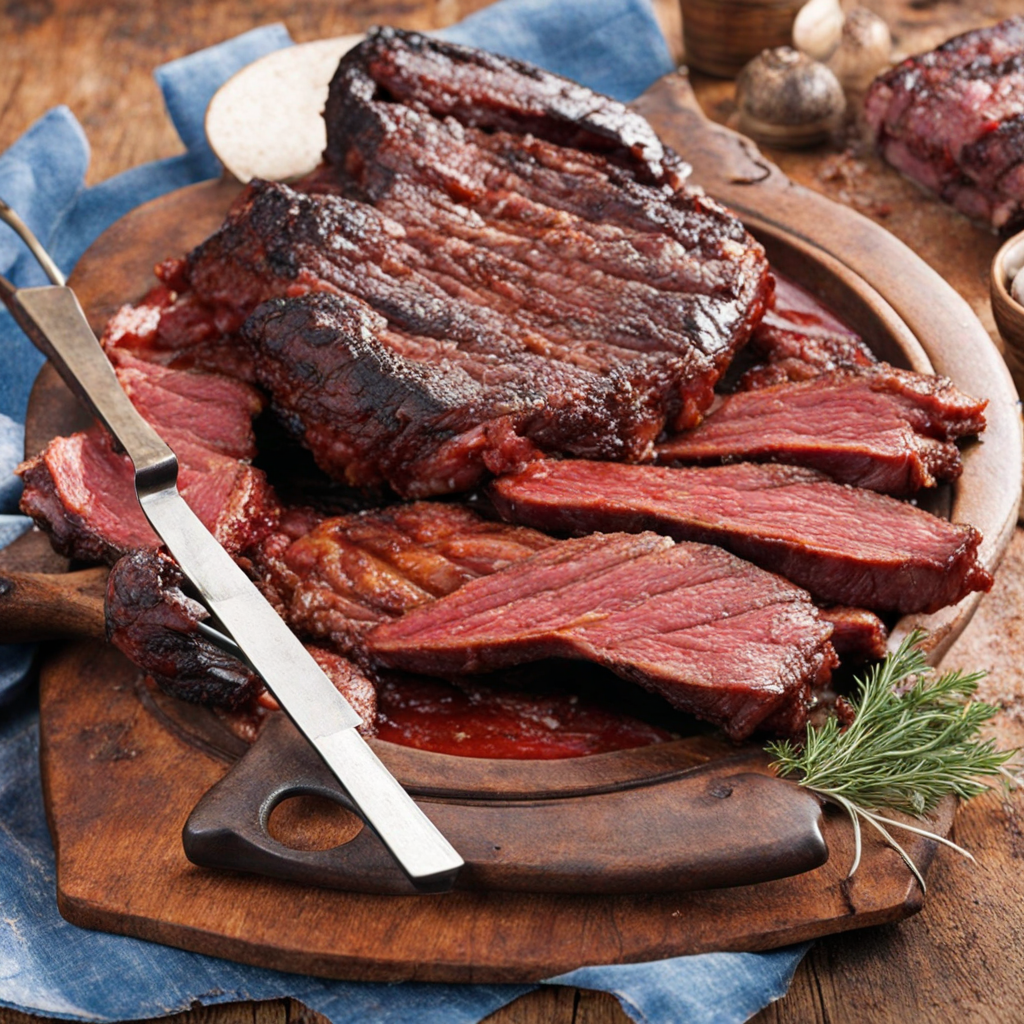Chivito
Chivito is a beloved Uruguayan sandwich that embodies the rich flavors and heartiness of the country's culinary traditions. At its core, the Chivito features a succulent grilled beef steak, typically tender and juicy, which is the star of this sandwich. The beef is often marinated to enhance its flavors, and once cooked, it is generously layered inside a soft, fresh bun, creating a satisfying base for the other ingredients that follow. Each bite delivers a delightful combination of textures and tastes that showcases the quality of Uruguayan meat. What truly sets the Chivito apart is its lavish assortment of toppings. Alongside the beef, you'll find crispy bacon, melted cheese, and slices of ripe tomatoes. The sandwich is often adorned with hard-boiled eggs and fresh lettuce, adding both richness and a refreshing crunch. A dollop of mayonnaise or chimichurri sauce can be added to elevate the dish, providing a creamy or tangy finish that ties all the components together. This bold combination of flavors makes each Chivito a feast for the senses, inviting you to savor every mouthful. The Chivito is not just a meal; it’s a cultural experience that captures the essence of Uruguayan hospitality. Often served with a side of crispy fries or a simple salad, this sandwich is perfect for any occasion, from casual lunches to festive gatherings. Whether enjoyed at a local eatery or crafted at home, the Chivito promises to deliver an unforgettable taste of Uruguay, reflecting the heart and soul of its people through food.
How It Became This Dish
The Chivito: A Culinary Journey through Uruguay #### Origins of the Chivito The Chivito, often hailed as Uruguay's national dish, is a multi-layered sandwich that has become a symbol of the country's culinary identity. Its origins can be traced back to the 1940s in the city of Punta del Este, a popular resort destination. According to local lore, the sandwich was first created by a restaurant owner named Antonio "Chivito" Carbonaro, who wanted to offer a hearty meal to his customers after a long day at the beach. The name "Chivito" translates to "little goat" in Spanish, which reflects the original concept of the dish. Initially, the sandwich featured thinly sliced goat meat, a common ingredient in Uruguayan cuisine, particularly in rural areas where goat farming was prevalent. However, as the dish gained popularity, it evolved to include a variety of ingredients, with beef becoming the centerpiece. #### Cultural Significance The Chivito quickly transcended its humble beginnings to become a cultural icon in Uruguay. It embodies the essence of Uruguayan hospitality and the country's affinity for good food. The sandwich is not merely a meal; it is a social experience often enjoyed in the company of friends and family. Its presence at gatherings, barbecues, and casual outings reflects the relaxed, communal lifestyle that characterizes Uruguayan culture. Moreover, the Chivito is deeply intertwined with Uruguay's culinary landscape, showcasing the country's agricultural resources. Uruguay is known for its high-quality beef, and the Chivito serves as a testament to the nation's pride in its livestock and meat industry. As such, the sandwich is more than just a comfort food; it is a celebration of Uruguay's agricultural heritage. #### The Evolution of the Chivito As the Chivito gained fame, its ingredients became more diverse, leading to the creation of various versions. The traditional Chivito consists of a grilled beef steak, often a sirloin or tenderloin, served in a bun with toppings that typically include mayonnaise, lettuce, tomato, and a fried egg. Additional ingredients can include bacon, cheddar cheese, olives, and even slices of ham. This combination creates a rich, flavorful experience that satisfies a wide range of palates. The evolution of the Chivito can also be seen in the rise of different regional adaptations. While the classic Chivito remains a favorite, variations have emerged across the country. Some regions have introduced local ingredients, such as spicy sauces or unique pickles, adding a personal touch to the traditional recipe. In Montevideo, the capital, gourmet versions have appeared, featuring artisanal bread and specialty sauces that elevate the dish to new culinary heights. Moreover, the Chivito has also embraced international influences. As Uruguayans travel and experience global cuisines, they have brought back new ideas, resulting in fusion versions of the sandwich. This adaptability speaks to the Chivito's resilience and its ability to incorporate elements from various cultures while still maintaining its core essence. #### The Chivito in Modern Times In recent years, the Chivito has carved its niche not just in homes and local eateries but also in the world of gourmet dining. Chefs have taken the beloved sandwich and reinvented it, experimenting with presentations and flavor combinations. Upscale restaurants now offer their takes on the Chivito, showcasing premium ingredients and culinary techniques that elevate the dish beyond its traditional roots. The rise of food trucks and casual dining establishments has also contributed to the Chivito's popularity. These venues often focus on high-quality, locally sourced ingredients, allowing them to serve a modernized version of the Chivito while staying true to its origins. This trend has helped spread the love for the sandwich beyond Uruguay's borders, introducing it to international audiences who may not have previously encountered this Uruguayan delight. Furthermore, the Chivito's presence is now felt at food festivals and cultural events, where it is celebrated as a quintessential Uruguayan dish. The sandwich has become a point of pride for Uruguayans, who take every opportunity to showcase it to visitors and promote their culinary heritage. #### The Chivito and Its Global Influence As Uruguay continues to evolve in a globalized world, the Chivito has begun to gain recognition beyond its national context. Food enthusiasts around the world are discovering the sandwich through social media platforms, culinary blogs, and international food festivals. Its unique combination of flavors and textures appeals to a broad audience, making it a suitable candidate for culinary exploration. In countries with significant Uruguayan immigrant populations, such as Argentina, the United States, and Spain, Chivito eateries have sprung up, bringing a taste of home to expatriates. These establishments often emphasize authenticity, serving traditional recipes that pay homage to the original creation. In this way, the Chivito serves as a culinary bridge, connecting Uruguayans abroad to their cultural roots while also introducing new audiences to the flavors of Uruguay. #### Conclusion Today, the Chivito stands as a vibrant symbol of Uruguay's rich culinary tradition. From its simple origins as a goat meat sandwich to its current status as a beloved national dish, the Chivito has undergone significant transformations while retaining its cultural significance. It reflects the heart of Uruguayan hospitality, the pride in local ingredients, and the adaptability of traditional recipes in the face of globalization. As it continues to evolve and capture the hearts of food lovers worldwide, the Chivito remains a testament to Uruguay's culinary heritage, showcasing the flavors that define this South American gem. Whether enjoyed at a bustling street vendor, a charming café, or an upscale restaurant, the Chivito invites everyone to savor not just a meal but a piece of Uruguay's rich history and culture.
You may like
Discover local flavors from Uruguay







